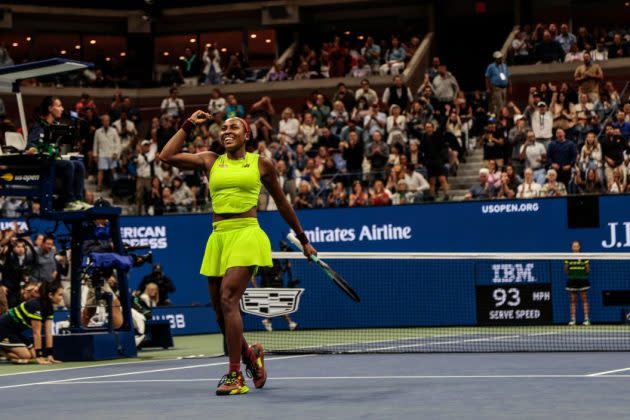U.S. Open’s Equal Pay Can’t Close the Tennis Gender Gap

Billie Jean King won the U.S. Open in 1972 but earned just $10,000 compared to the $25,000 pocketed by the men’s champion Ilie Nastase. She declared that she would not play the next year if the prize money was not equal. In 1973, exactly 50 years ago, the U.S. Open became the first major to pay men and women equally.
That monumental decision proved to be way ahead of its time. The Australian Open has only consistently offered equal pay since 2001, and the French Open and Wimbledon didn’t follow suit until 2007.
More from Sportico.com
U.S. Open Finalists' Prize Grows as Early Round Cash Plateaus
NFL Teams Find Practice Makes Perfect Space for Sales and Sponsors
Women's College Sports Crowds Show Power of Creative Thinking
“By being the first sport to offer equal prize money, we were also making a very important statement to society as a whole,” UTSA chairman of the board Brian Hainline said at a press conference in August. “Offering equal opportunity and equal pay for men and women across the globe.”
Well, only some places across the globe. And not in Cincinnati.
Sixteen years after all four Grand Slams first guaranteed equal prize money, women’s tennis is surging in popularity and a plethora of young female stars have emerged. Yet, the pay gap in tennis exists basically just as it did in 2007, when the top 10 highest-earning men made 1.44 times the top 10 highest-earning women. This year, as of the start of the U.S. Open, the inequality ratio is still a hefty 1.36.
The pandemic, and subsequently the inability to hold tournaments in China, where women’s prize money has been grown recently, took a toll on the tour’s earnings. Across 2020, 2021 and 2022, the top 10 male players earned 53% more than their female counterparts.
Last year was a prime example of how stacked the deck is against female players. Iga Swiatek had one of the most dominant seasons of any tennis player, male or female, in recent memory, claiming two of the four Grand Slams and winning 37 straight matches. By the end of the calendar, however, Novak Djokovic and Carlos Alcaraz had both made more money from on-court performance despite each winning only one major and the former playing in six fewer tournaments than Swiatek.
Overall, five of the top six tennis players in 2022 prize money were men.
Some of the inequality stems from 250- and 500-level tournaments, which are less prestigious and award fewer rankings points than the majors and 1000-level events. Most lower-level tournaments are either men’s or women’s, not both. The total prize money available for players at the 250 level on the ATP Tour was more than three times that of the WTA Tour in 2019, 2022 and 2023.
Many marquee events, however, in which the same number of men and women both play simultaneously, still pay men far more. Notably, unlike in the Grand Slams, men and women both play three-set matches. The Italian Open paid out roughly $8.4 million to male players in 2023 and just $3.9 million to female players. The pair of big summer hard-court tournaments in North America, the Canadian Open and Cincinnati Open, each allocated $6.6 million in prize money for men and $2.8 million for women.
“It needs to be improved,” 2023 Cincinnati Open champion Coco Gauff said. “My matches were more crowded or the same as some of the top seeds on the men's side, so I don't think it's an attraction issue. Obviously in some tournaments, yes, but especially in the 1000 events, I don't think it's necessarily an attraction issue.”
The Cincinnati tournament’s inequality is particularly glaring given that it was owned by the USTA up until last year, the same organization that hosts the U.S. Open.
“Certainly with Cincinnati, it was and still right now is a different player commitment system, different broadcast agreements,” U.S. Open tournament director Stacey Allaster said when questioned about the pay gap in non-major events. “We know now, together with [WTA chief executive] Steve Simon's leadership, the CVC's partnership, that Cincinnati, Canada, Rome are now on a pathway for equal prize money.”
Indeed, this summer the WTA approved a plan to achieve equal pay across the tennis calendar by 2033. As part of the proposal, all tournaments at the 500 and 1000 level that feature both men and women will pay them equally by 2027.
Gender equality in sports is about more than just finances, however. “Whether you're looking at participation, whether you're looking at viewership, attendance, prize money at the U.S. Open, we are 50/50 down the middle in every aspect,” USTA CEO Lew Sherr said. “It's more than just equal prize money, right? When you look at how we schedule matches, we're conscious of who's playing in prime time, who's on Arthur Ashe.”
The same can’t be said of other tournaments, yet. Just this year, the French Open came under fire for featuring only one women’s match in its slate of nighttime matches over the course of the two-week tournament.
In the wider sports landscape, though, tennis is an outlier–a positive one–when it comes to the prominence and financial success of women. Seven of the 10 highest-paid female athletes in the world in 2022 were tennis players, according to Sportico’s research. In 2019, the entire top 10 list was composed of tennis players.
“I think we have a long way to go,” Gauff said. “But I am proud to say where we are now, especially in the Grand Slams.”
Best of Sportico.com
